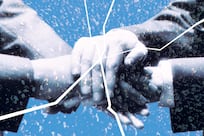"Homo homini lupus est" goes the old Latin truism: man is a wolf to man. The ancient Romans blandly accepted this fact of human existence – Cicero, their foremost public thinker, not only executed political enemies but was himself executed by political enemies – but the essayist and public thinker Abram de Swaan, professor emeritus at the University of Amsterdam, has devoted years to studying humans killing humans, and his latest book, The Killing Compartments: The Mentality of Mass Murder, is a penetrating and thrillingly thought-provoking analysis of the subject.
De Swaan’s concentration is asymmetrical killing; he’s less interested in the clash of armies by night than he is by the wide-scale murder of non-combatants – not just strictly genocide, he carefully distinguishes, but any wide-scale killings by a state apparatus conducted against non-soldiers. And despite his deliberately provocative opening line, “We live in peaceful times”, his primary focus – the 20th century – provides him with plenty of examples to study. The Armenian massacre, the killing fields of Cambodia, the government-sponsored famines of Mao’s China, the pogroms of Stalin, of course the Nazis and their Final Solution – states murdered non-combatants in the 20th century on a sheer scale undreamt of by the Romans, or the Persians, or the Huns.
De Swaan seeks to understand not only why this is so, but also how it’s so, what the actual interpersonal mechanisms are by which states can do these things. After all, he isn’t for the most part studying soldiers under arms – he’s studying ordinary people pressed into the task of killing other ordinary people, and the numbers are staggering. “Thousands, perhaps tens of thousands of people are led to destroy hundreds of thousands, perhaps millions of people,” he writes. “But before that, most of them may not have harmed a living soul. Once it is over, most of them by far will never again physically hurt another person. Where does this extreme violence come from, and how can it disappear again, seemingly without a trace?”
His fundamental contention is that “mass annihilation” – the more or less systematic killing of large numbers of civilians by a state apparatus – occurs in societies that have become “compartmentalised” in one to four ways: mentally, socially, institutionally or physically. He asserts early on in his book that it simply “won’t do” to fall back on that old Roman truism; man, he claims, is not a wolf to man – not generally. Such depredation only happens when compartmentalisation has subjected certain elements of a population to stresses well outside their normal environment. Compartmentalisation likewise extends to the victims: they’re cut off, isolated from extended communities, characterised as inhuman.
One of the many brilliant conceptual strokes of The Killing Compartments is de Swaan's breakdown of these stresses into four general categories, four "modes" by which mass killings are facilitated. The first and perhaps most straightforward of these is something he calls "conqueror's frenzy", which "occurs far from home, largely unbeknown to the domestic public", and is "perpetrated exclusively by the military". The horror inflicted on the Belgian population by advancing German soldiers in 1914 would be an example of this, or even more wide-scale events such as the "Rape of Nanking" carried out by Japanese soldiers in 1937. The stresses here are at least familiar: front-line soldiers, under arms and anxious about being killed, unleash their pent-up anxieties in the form of rage.
De Swaan’s second mode is “rule by terror”, which “employs professional violence specialists and a dedicated system of insulated detention and extermination sites”. Here the reader might think of operations such as the gulag system of Soviet Russia, where terror motivated ordinary citizens to spy and inform on each other (including, infamously, family members turning on each other to save themselves) and the arrested were sent to “insulated” extermination sites, such as the distant work camps of Siberia.
Opposing the more formalised state-run system of rule by terror is another of de Swaan’s modes of annihilation, the “megapogrom”, in which “a wave of apparently spontaneous deadly local riots” erupt along the fracture points of a society, creating “a free-for-all for whoever joins the slaughter of a vaguely defined target group”. Pressure events, de Swaan claims, such as military defeat or social upheaval, “provoke, synchronise, and concatenate these local events into one huge campaign of annihilation, condoned if not covertly or even openly encouraged, by the regime in power”. A standout example of this would be the Red Guard groups that appeared and flourished during Mao Zedong’s Cultural Revolution, roving bands of young people exacting ad hoc punishments on alleged offenders without the direct cooperation of the state police.
And the most seemingly irrational of all four of de Swaan’s killing modes would be the “losers’ triumph”, in which “genocidal regimes facing imminent destruction by an enemy army surprisingly continue and perhaps intensify their campaign to annihilate the target group” – as seen in recent history during the genocide in Rwanda, when the Hutu-led government intensified its slaughter of Tutsi non-combatants even as the RPF forces were advancing from the north.
De Swaan hardly needs to point out that the darkest and most ready 20th-century exemplar of all four of these modes of annihilation is Nazi Germany, and it’s natural to read his book as a response, in part, to the concept of “the banality of evil” first popularised in Hannah Arendt’s 1963 account of Adolf Eichmann’s war-crimes trial in Jerusalem. De Swaan takes issue with Arendt’s characterisation of Eichmann as just one ordinary, faceless bureaucrat in a state mechanism of terror (he points out, for instance, that “even at the time, it was well known that Eichmann had been a fanatical Jew hunter who knew full well what fate lay in store for his prey”); it’s his fundamental contention that evil is not banal, and that it’s only perpetrated on a large scale by ordinary people under extraordinary pressures.
“I very much doubt that I, or most of my readers for that matter,” he protests, “on being brought into the killing site would have started, like automatons, clubbing, knifing, shooting, gassing people to death by the thousands, for weeks and months at a stretch.”
In short, The Killing Compartments is an elaborate exculpation of humanity from the charge of being genetic "genocidaires"; de Swaan argues that turning ordinary people into mass killers requires either extreme duress – the threat of war or economic destruction – or extensive preparation, in which certain target groups are compartmentalised to such a point that their slaughter no longer seems abhorrent. As he puts it, "There is nothing 'banal' about such an experience."
It’s a masterful, clutter-clearing summation, and it’s only slightly hampered by the fact that de Swaan has engineered his categories to be all-inclusive. If his overview has a flaw, it’s not found in “conquerors’ frenzy” or “rule by terror” or “losers’ triumph” but in his concept of the “megapogrom”, in which the ruling state steps back and allows natural upwellings of homicidal, genocidal aggression to make accomplices out of the general population.
De Swaan is forced to admit that in such cases compartmentalism is either “much less elaborate” or non-existent; “mobs seem to assemble spontaneously to murder their targeted victims out in the open, in a brief period of blood frenzy”. He tries to mitigate this by pointing out that those crowds are suffering from long-term pressures, but what general populace doesn’t feel long-term pressures?
Likewise his contention that most 20th-century examples of mass annihilation “never proceeded in dispassionate, calculated destruction”. Without exception, he writes, these episodes were “grisly, bloody, and wild”. But the 20 or so mass annihilations de Swaan examines almost universally belie this characterisation, as does his own concept of the spontaneously flaring “megapogrom”: in virtually all the cases he cites, from Stalin’s institutionalised famines to the busy train schedules of the Final Solution to the extensive slaughter plannings in the Rwandan genocide, there’s a depressing abundance of dispassion and calculation. Enough, perhaps, to justify a harder look at whether or not humans are hardwired for killing.
Steve Donoghue is managing editor of Open Letters Monthly.
thereview@thenational.ae










